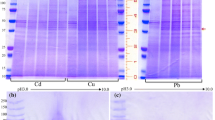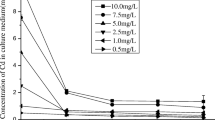Abstract
Many investigators have reported that water hyacinth plants can accumulate toxic heavy metal ions and may be useful for elutriation of polluted water. The purpose of our study was to search for the mechanism by which these plants tolerate and accumulate toxic metal ions.
Cadmium was accumulated in the plants against the concentration gradient, mostly as a soluble form in the cytoplasm. Isolation and Purification of Cd-binding protein with sephadex A-25 and fractionation on sephadex G-100 showed that the accumulated Cd was associated with two major protein fractions.The first with molecular weight 25 - 20 kD contained about 35% of bound Cd. The second fraction with molecular weight 12 - 8 kD contained about 40% of bound Cd. The two forms were found also in water hyacinth cultivated in Nile water as a control, although the amount of Cd accumulated was less than those exposed to excess Cd.
Similar content being viewed by others
References
Bartolf, M., Brennen, E. and Price, C.A. (1980): Partial characterization of a cadmium-binding protein from the roots of Cd-treated tomato.Plant Physiol. 66: 438–441.
Casterline, J.L. and Yip, G. (1975): The distribution and binding cadmium in Oyster, soybean and rat liver and kidney.Arch. Env. Contam. Toxicol. 3: 319–329.
Cataldo, D.A., Garland, T.R. and Wildung, R.E. (1981): Cadmium distribution and chemical fate in soybean plants.Plant Physiol. 68: 835–839.
Delhaize, E., Jackson, P.J., Lung, L.D. and Robinson N.J. (1989): Poly (Y-glutamylcysteinyl) glycine synthesis inDatura innoxia and binding with cadmium.Plant Physiol. 89: 700–706.
El-Enany, A.E. (1992): Effect of cadmium on physiological activities of some economic plants and their tissue culture. Ph.D Thesis, Assiut University, Assiut, Egypt.
Ernst, W. (1972): Zinc- and cadmiummissionen auf Boden and Pflanzen in der Umgebung einer Zinkhuette.Ber. Dtsch. Bot. GES. 85: 295–300.
Gekeler, W., Grill, E., Winnacker, E.L. and Zenk, M.H. (1989): Survey of the plant kingdom for the ability to bind heavy metals through phytochelatins.Z Naturfor 44: 361–369.
Grill, E., Winnacker, E.L. and Zenk, M.H. (1985): Phytochelatinss, the principals heavy metal complexing peptides of higher plants.Sci. 230: 674–676.
Holm, L.G., Plucknelt, D.L., Pancho, J.V. and Herberger, J.P. (1977): The world'worst weeds. Distribution and Biology. The University Press of Hawaii, Honolulu, 597 pp.
Lerch, K. (1980): Copper metallothioneins, a copper-binding protein fromNeurospora crassa.Nature 248: 368–370.
Macara, I.G. (1978): Accumulation of yeast to toxic levels of cadmium ions.J. Gen. Microbiol. 104: 321–324.
Muramoto, S. and Oki (1983): Removal of some heavy metals from polluted water by water hyacinth Eichhornia crassipes.Bull. Environm. Contam. Toxicol. 30: 170–177.
Muramoto, S., Oki, Y., Nishiizaki, H. and Aoyama, I.. (1989): Variation in some elements contents of water hyacinth due to cadmium or nickel with or without anionic surface active agents.J. Environ. Sci. Health, A 24(8): 925–934.
Rauser, W.E. (1990): Phytochelatins.Ann. Rev. Biochem. 59: 61–86.
Ravera, O. (1984): Cadmium in freshwater ecosystems.Experientia 40: 1–13.
Reese, N.R., Mehra, R.K., Barttarbet, E. and Winge, D.R. (1988): Studies on theY-glutamyl Cubinding peptides fromSchizosaccharomyces pombe.J.Biol. Chem. 236: 4186–4189.
Robinson, N.J., Bartolf, R.L., Anderson, P.J., Delhaize, E., Breger, J.M. and Jackson, P.J. (1988): Biosynthesis of poly (Y-glutamylcysteinyl)glycine in cadmium-tolerantDatura innoxia cells.Plant Sci. 56: 197–204.
Scheller, H.V., Hung, B., Hatch, E. and Goldsbrough, P.B. (1987): Phytochelatins synthesis and glutathione levels in response to heavy metals in tomato callus.Plant Physiol. 85: 1031–1035.
Tachholm, V (1974): Students flora of Egypt. Cairo University.
Tosmett, A.B. and Thurman, D.A. (1988): Molecular biology of metal tolerance of plants.Plant, Cell and Environ. 11: 383–394.
Valle, B.L. and Uwdlmer, D.D. (1972): Biochemical effect of mercury, cadmium and lead.Ann. Rev. Biochem. 41: 91–128.
Vora, A.B. and Rao, V. (1988): Water hyacinth as a scavenger of heavy metals from polluted waters of the river Sabarmati Ahmedabad.Advances in Plant Sciences 1(1): 1–6.
Weigel, H.J. and Jager, H.G. (1980a): Subcellular distribution and chemical form of cadmium in bean plants.Plant Physiol. 65: 480–482.
Weigel, H.J. and Jager, H.G. (1980b): Different effect of cadmium in vitro andin vivo on enzyme activities in bean plants (Phaseolus vulgaris L. cu. sankt Andreas).Z. Pflanzenphysiol. 97: 103–113.
Wolverton, B.C. (1975): Water hyacinth for removal of cadmium and nickel from polluted waters. NASA Technical Memorandum. TM-X-72721.
Wolverton, B.C. and McDonald, R.C. (1975): Water hyacinth and alligater weeds for removal of silver, cobalt and strontium from polluted waters. NASA Technical Memorandum. TM-x-72727.
Yahya, M.N. (1990): The absorption of metal ions byEichhornia crassipes Chem. speciation and Bioavailab.2: 82–91 (C.F Weedabst. 40, abt.191).
Author information
Authors and Affiliations
Rights and permissions
About this article
Cite this article
El-Enany, A.E., Maien, A.M.A. Isolation of Cd-binding protein of water hyacinth (Eichhornia crassipes) grown in Nile river water. Water Air Soil Pollut 87, 357–362 (1996). https://doi.org/10.1007/BF00696847
Received:
Accepted:
Issue Date:
DOI: https://doi.org/10.1007/BF00696847




